Sustainable Marketing Strategies for Hershey Food Corporation
VerifiedAdded on 2023/06/12
|13
|3092
|274
AI Summary
This report analyzes Hershey Food Corporation's marketing mix and SWOT analysis, and discusses the sustainable marketing principles used by the company to enhance its competitiveness, growth, and market sustainability.
Contribute Materials
Your contribution can guide someone’s learning journey. Share your
documents today.
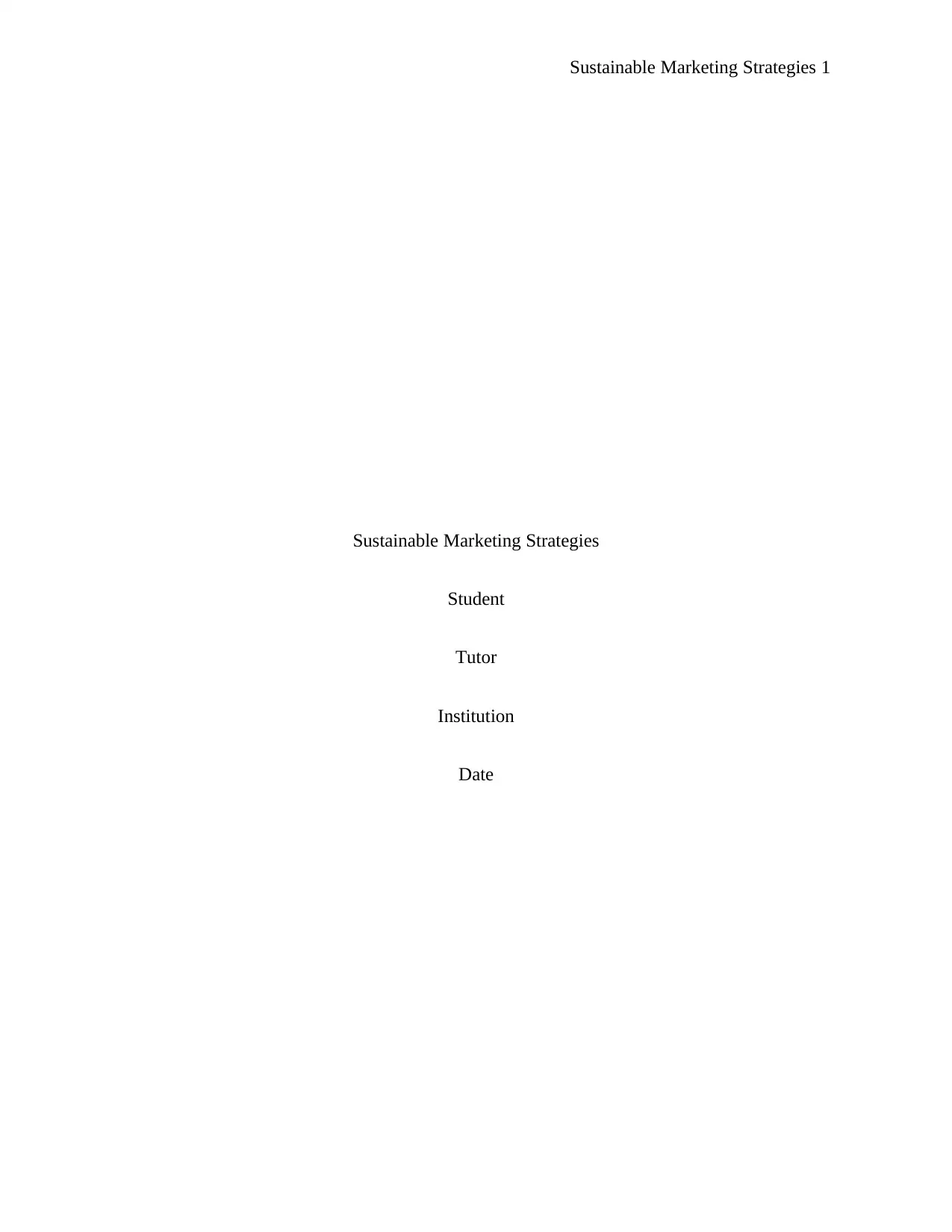
Sustainable Marketing Strategies 1
Sustainable Marketing Strategies
Student
Tutor
Institution
Date
Sustainable Marketing Strategies
Student
Tutor
Institution
Date
Secure Best Marks with AI Grader
Need help grading? Try our AI Grader for instant feedback on your assignments.
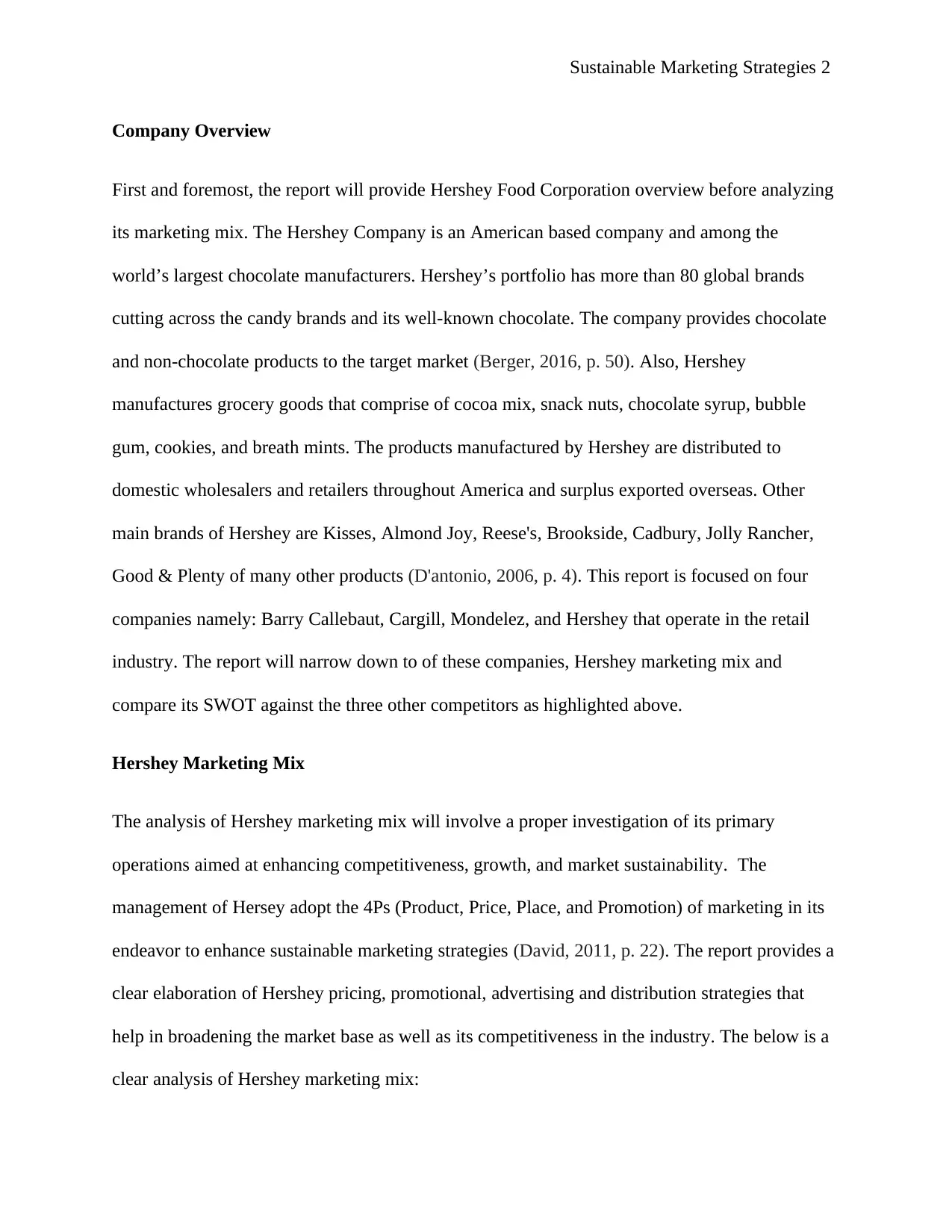
Sustainable Marketing Strategies 2
Company Overview
First and foremost, the report will provide Hershey Food Corporation overview before analyzing
its marketing mix. The Hershey Company is an American based company and among the
world’s largest chocolate manufacturers. Hershey’s portfolio has more than 80 global brands
cutting across the candy brands and its well-known chocolate. The company provides chocolate
and non-chocolate products to the target market (Berger, 2016, p. 50). Also, Hershey
manufactures grocery goods that comprise of cocoa mix, snack nuts, chocolate syrup, bubble
gum, cookies, and breath mints. The products manufactured by Hershey are distributed to
domestic wholesalers and retailers throughout America and surplus exported overseas. Other
main brands of Hershey are Kisses, Almond Joy, Reese's, Brookside, Cadbury, Jolly Rancher,
Good & Plenty of many other products (D'antonio, 2006, p. 4). This report is focused on four
companies namely: Barry Callebaut, Cargill, Mondelez, and Hershey that operate in the retail
industry. The report will narrow down to of these companies, Hershey marketing mix and
compare its SWOT against the three other competitors as highlighted above.
Hershey Marketing Mix
The analysis of Hershey marketing mix will involve a proper investigation of its primary
operations aimed at enhancing competitiveness, growth, and market sustainability. The
management of Hersey adopt the 4Ps (Product, Price, Place, and Promotion) of marketing in its
endeavor to enhance sustainable marketing strategies (David, 2011, p. 22). The report provides a
clear elaboration of Hershey pricing, promotional, advertising and distribution strategies that
help in broadening the market base as well as its competitiveness in the industry. The below is a
clear analysis of Hershey marketing mix:
Company Overview
First and foremost, the report will provide Hershey Food Corporation overview before analyzing
its marketing mix. The Hershey Company is an American based company and among the
world’s largest chocolate manufacturers. Hershey’s portfolio has more than 80 global brands
cutting across the candy brands and its well-known chocolate. The company provides chocolate
and non-chocolate products to the target market (Berger, 2016, p. 50). Also, Hershey
manufactures grocery goods that comprise of cocoa mix, snack nuts, chocolate syrup, bubble
gum, cookies, and breath mints. The products manufactured by Hershey are distributed to
domestic wholesalers and retailers throughout America and surplus exported overseas. Other
main brands of Hershey are Kisses, Almond Joy, Reese's, Brookside, Cadbury, Jolly Rancher,
Good & Plenty of many other products (D'antonio, 2006, p. 4). This report is focused on four
companies namely: Barry Callebaut, Cargill, Mondelez, and Hershey that operate in the retail
industry. The report will narrow down to of these companies, Hershey marketing mix and
compare its SWOT against the three other competitors as highlighted above.
Hershey Marketing Mix
The analysis of Hershey marketing mix will involve a proper investigation of its primary
operations aimed at enhancing competitiveness, growth, and market sustainability. The
management of Hersey adopt the 4Ps (Product, Price, Place, and Promotion) of marketing in its
endeavor to enhance sustainable marketing strategies (David, 2011, p. 22). The report provides a
clear elaboration of Hershey pricing, promotional, advertising and distribution strategies that
help in broadening the market base as well as its competitiveness in the industry. The below is a
clear analysis of Hershey marketing mix:
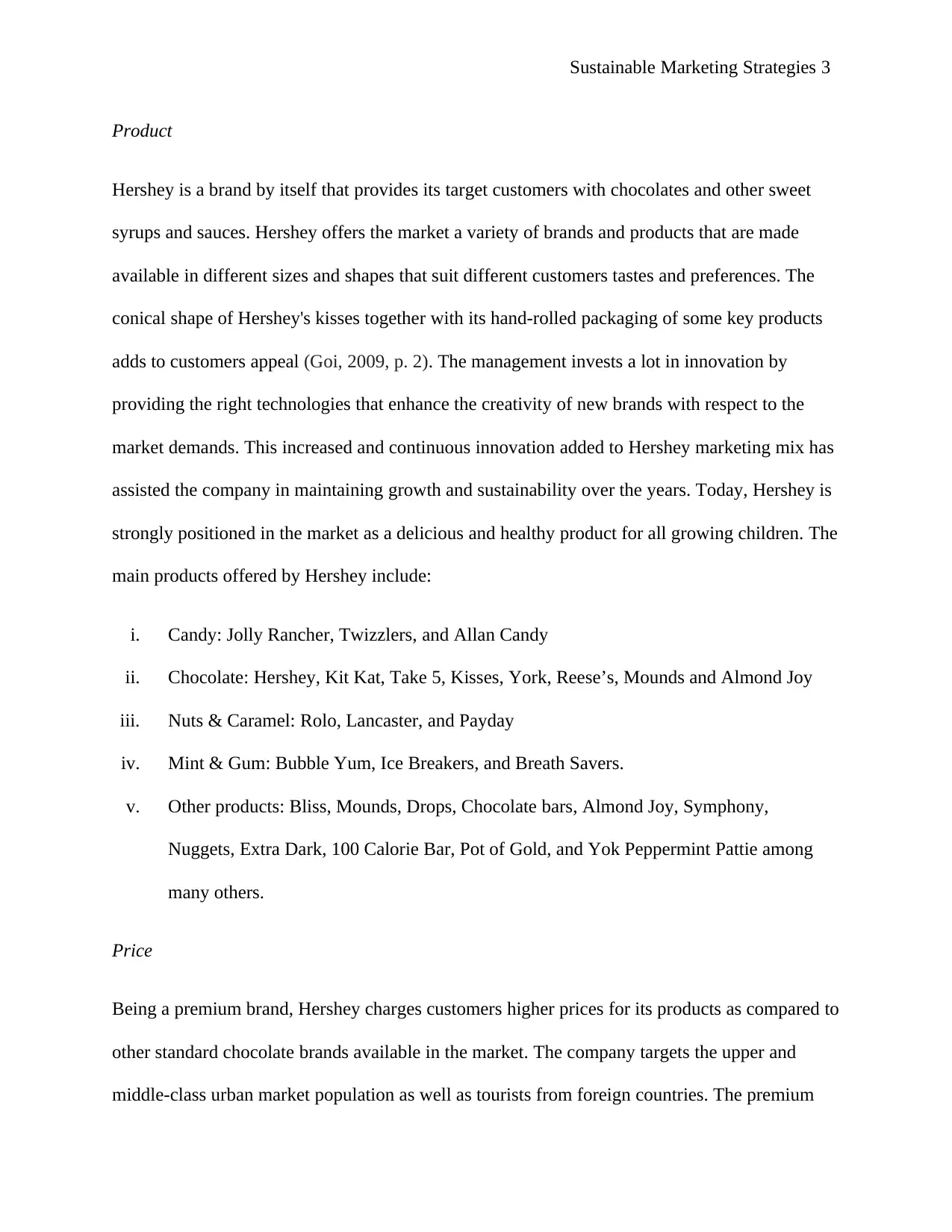
Sustainable Marketing Strategies 3
Product
Hershey is a brand by itself that provides its target customers with chocolates and other sweet
syrups and sauces. Hershey offers the market a variety of brands and products that are made
available in different sizes and shapes that suit different customers tastes and preferences. The
conical shape of Hershey's kisses together with its hand-rolled packaging of some key products
adds to customers appeal (Goi, 2009, p. 2). The management invests a lot in innovation by
providing the right technologies that enhance the creativity of new brands with respect to the
market demands. This increased and continuous innovation added to Hershey marketing mix has
assisted the company in maintaining growth and sustainability over the years. Today, Hershey is
strongly positioned in the market as a delicious and healthy product for all growing children. The
main products offered by Hershey include:
i. Candy: Jolly Rancher, Twizzlers, and Allan Candy
ii. Chocolate: Hershey, Kit Kat, Take 5, Kisses, York, Reese’s, Mounds and Almond Joy
iii. Nuts & Caramel: Rolo, Lancaster, and Payday
iv. Mint & Gum: Bubble Yum, Ice Breakers, and Breath Savers.
v. Other products: Bliss, Mounds, Drops, Chocolate bars, Almond Joy, Symphony,
Nuggets, Extra Dark, 100 Calorie Bar, Pot of Gold, and Yok Peppermint Pattie among
many others.
Price
Being a premium brand, Hershey charges customers higher prices for its products as compared to
other standard chocolate brands available in the market. The company targets the upper and
middle-class urban market population as well as tourists from foreign countries. The premium
Product
Hershey is a brand by itself that provides its target customers with chocolates and other sweet
syrups and sauces. Hershey offers the market a variety of brands and products that are made
available in different sizes and shapes that suit different customers tastes and preferences. The
conical shape of Hershey's kisses together with its hand-rolled packaging of some key products
adds to customers appeal (Goi, 2009, p. 2). The management invests a lot in innovation by
providing the right technologies that enhance the creativity of new brands with respect to the
market demands. This increased and continuous innovation added to Hershey marketing mix has
assisted the company in maintaining growth and sustainability over the years. Today, Hershey is
strongly positioned in the market as a delicious and healthy product for all growing children. The
main products offered by Hershey include:
i. Candy: Jolly Rancher, Twizzlers, and Allan Candy
ii. Chocolate: Hershey, Kit Kat, Take 5, Kisses, York, Reese’s, Mounds and Almond Joy
iii. Nuts & Caramel: Rolo, Lancaster, and Payday
iv. Mint & Gum: Bubble Yum, Ice Breakers, and Breath Savers.
v. Other products: Bliss, Mounds, Drops, Chocolate bars, Almond Joy, Symphony,
Nuggets, Extra Dark, 100 Calorie Bar, Pot of Gold, and Yok Peppermint Pattie among
many others.
Price
Being a premium brand, Hershey charges customers higher prices for its products as compared to
other standard chocolate brands available in the market. The company targets the upper and
middle-class urban market population as well as tourists from foreign countries. The premium
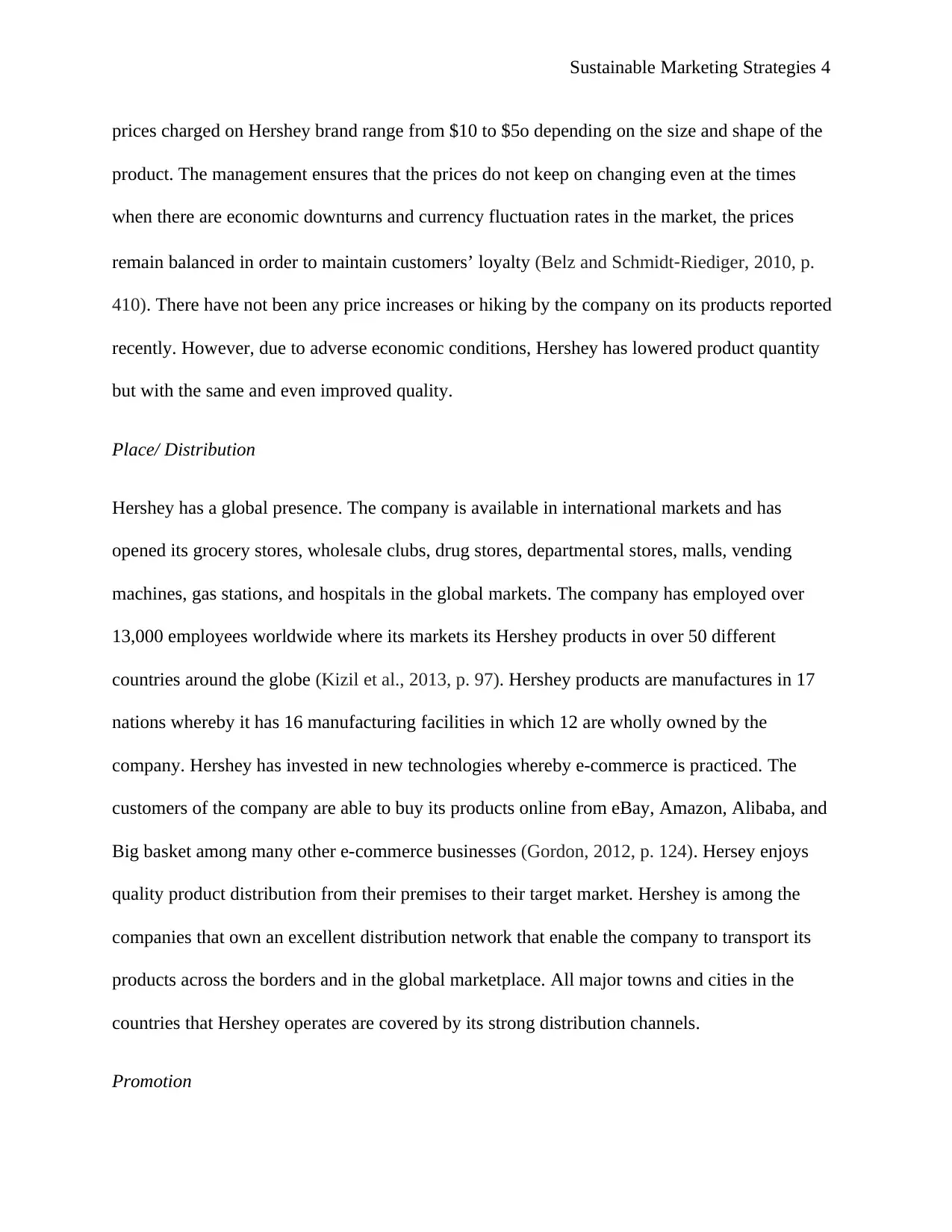
Sustainable Marketing Strategies 4
prices charged on Hershey brand range from $10 to $5o depending on the size and shape of the
product. The management ensures that the prices do not keep on changing even at the times
when there are economic downturns and currency fluctuation rates in the market, the prices
remain balanced in order to maintain customers’ loyalty (Belz and Schmidt‐Riediger, 2010, p.
410). There have not been any price increases or hiking by the company on its products reported
recently. However, due to adverse economic conditions, Hershey has lowered product quantity
but with the same and even improved quality.
Place/ Distribution
Hershey has a global presence. The company is available in international markets and has
opened its grocery stores, wholesale clubs, drug stores, departmental stores, malls, vending
machines, gas stations, and hospitals in the global markets. The company has employed over
13,000 employees worldwide where its markets its Hershey products in over 50 different
countries around the globe (Kizil et al., 2013, p. 97). Hershey products are manufactures in 17
nations whereby it has 16 manufacturing facilities in which 12 are wholly owned by the
company. Hershey has invested in new technologies whereby e-commerce is practiced. The
customers of the company are able to buy its products online from eBay, Amazon, Alibaba, and
Big basket among many other e-commerce businesses (Gordon, 2012, p. 124). Hersey enjoys
quality product distribution from their premises to their target market. Hershey is among the
companies that own an excellent distribution network that enable the company to transport its
products across the borders and in the global marketplace. All major towns and cities in the
countries that Hershey operates are covered by its strong distribution channels.
Promotion
prices charged on Hershey brand range from $10 to $5o depending on the size and shape of the
product. The management ensures that the prices do not keep on changing even at the times
when there are economic downturns and currency fluctuation rates in the market, the prices
remain balanced in order to maintain customers’ loyalty (Belz and Schmidt‐Riediger, 2010, p.
410). There have not been any price increases or hiking by the company on its products reported
recently. However, due to adverse economic conditions, Hershey has lowered product quantity
but with the same and even improved quality.
Place/ Distribution
Hershey has a global presence. The company is available in international markets and has
opened its grocery stores, wholesale clubs, drug stores, departmental stores, malls, vending
machines, gas stations, and hospitals in the global markets. The company has employed over
13,000 employees worldwide where its markets its Hershey products in over 50 different
countries around the globe (Kizil et al., 2013, p. 97). Hershey products are manufactures in 17
nations whereby it has 16 manufacturing facilities in which 12 are wholly owned by the
company. Hershey has invested in new technologies whereby e-commerce is practiced. The
customers of the company are able to buy its products online from eBay, Amazon, Alibaba, and
Big basket among many other e-commerce businesses (Gordon, 2012, p. 124). Hersey enjoys
quality product distribution from their premises to their target market. Hershey is among the
companies that own an excellent distribution network that enable the company to transport its
products across the borders and in the global marketplace. All major towns and cities in the
countries that Hershey operates are covered by its strong distribution channels.
Promotion
Secure Best Marks with AI Grader
Need help grading? Try our AI Grader for instant feedback on your assignments.
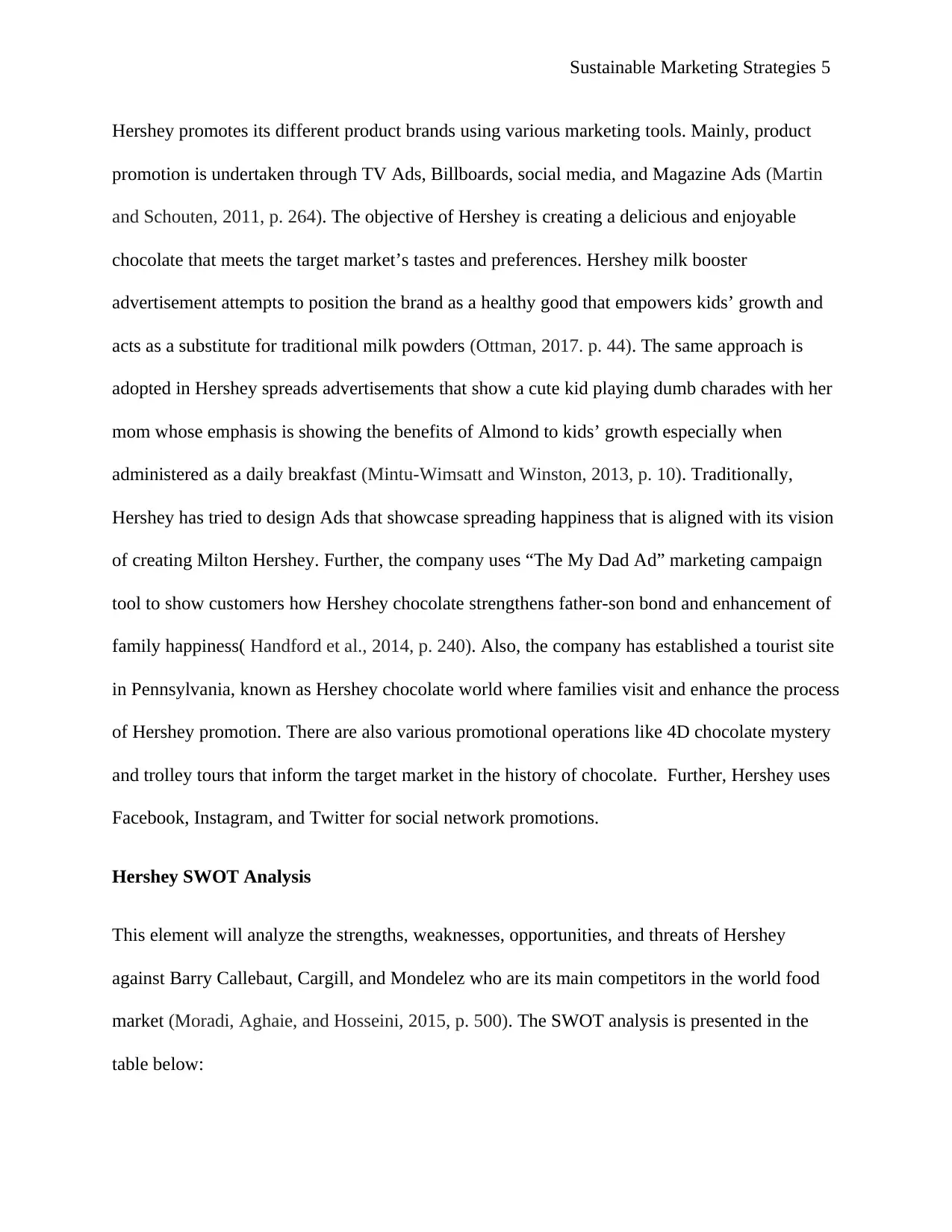
Sustainable Marketing Strategies 5
Hershey promotes its different product brands using various marketing tools. Mainly, product
promotion is undertaken through TV Ads, Billboards, social media, and Magazine Ads (Martin
and Schouten, 2011, p. 264). The objective of Hershey is creating a delicious and enjoyable
chocolate that meets the target market’s tastes and preferences. Hershey milk booster
advertisement attempts to position the brand as a healthy good that empowers kids’ growth and
acts as a substitute for traditional milk powders (Ottman, 2017. p. 44). The same approach is
adopted in Hershey spreads advertisements that show a cute kid playing dumb charades with her
mom whose emphasis is showing the benefits of Almond to kids’ growth especially when
administered as a daily breakfast (Mintu-Wimsatt and Winston, 2013, p. 10). Traditionally,
Hershey has tried to design Ads that showcase spreading happiness that is aligned with its vision
of creating Milton Hershey. Further, the company uses “The My Dad Ad” marketing campaign
tool to show customers how Hershey chocolate strengthens father-son bond and enhancement of
family happiness( Handford et al., 2014, p. 240). Also, the company has established a tourist site
in Pennsylvania, known as Hershey chocolate world where families visit and enhance the process
of Hershey promotion. There are also various promotional operations like 4D chocolate mystery
and trolley tours that inform the target market in the history of chocolate. Further, Hershey uses
Facebook, Instagram, and Twitter for social network promotions.
Hershey SWOT Analysis
This element will analyze the strengths, weaknesses, opportunities, and threats of Hershey
against Barry Callebaut, Cargill, and Mondelez who are its main competitors in the world food
market (Moradi, Aghaie, and Hosseini, 2015, p. 500). The SWOT analysis is presented in the
table below:
Hershey promotes its different product brands using various marketing tools. Mainly, product
promotion is undertaken through TV Ads, Billboards, social media, and Magazine Ads (Martin
and Schouten, 2011, p. 264). The objective of Hershey is creating a delicious and enjoyable
chocolate that meets the target market’s tastes and preferences. Hershey milk booster
advertisement attempts to position the brand as a healthy good that empowers kids’ growth and
acts as a substitute for traditional milk powders (Ottman, 2017. p. 44). The same approach is
adopted in Hershey spreads advertisements that show a cute kid playing dumb charades with her
mom whose emphasis is showing the benefits of Almond to kids’ growth especially when
administered as a daily breakfast (Mintu-Wimsatt and Winston, 2013, p. 10). Traditionally,
Hershey has tried to design Ads that showcase spreading happiness that is aligned with its vision
of creating Milton Hershey. Further, the company uses “The My Dad Ad” marketing campaign
tool to show customers how Hershey chocolate strengthens father-son bond and enhancement of
family happiness( Handford et al., 2014, p. 240). Also, the company has established a tourist site
in Pennsylvania, known as Hershey chocolate world where families visit and enhance the process
of Hershey promotion. There are also various promotional operations like 4D chocolate mystery
and trolley tours that inform the target market in the history of chocolate. Further, Hershey uses
Facebook, Instagram, and Twitter for social network promotions.
Hershey SWOT Analysis
This element will analyze the strengths, weaknesses, opportunities, and threats of Hershey
against Barry Callebaut, Cargill, and Mondelez who are its main competitors in the world food
market (Moradi, Aghaie, and Hosseini, 2015, p. 500). The SWOT analysis is presented in the
table below:
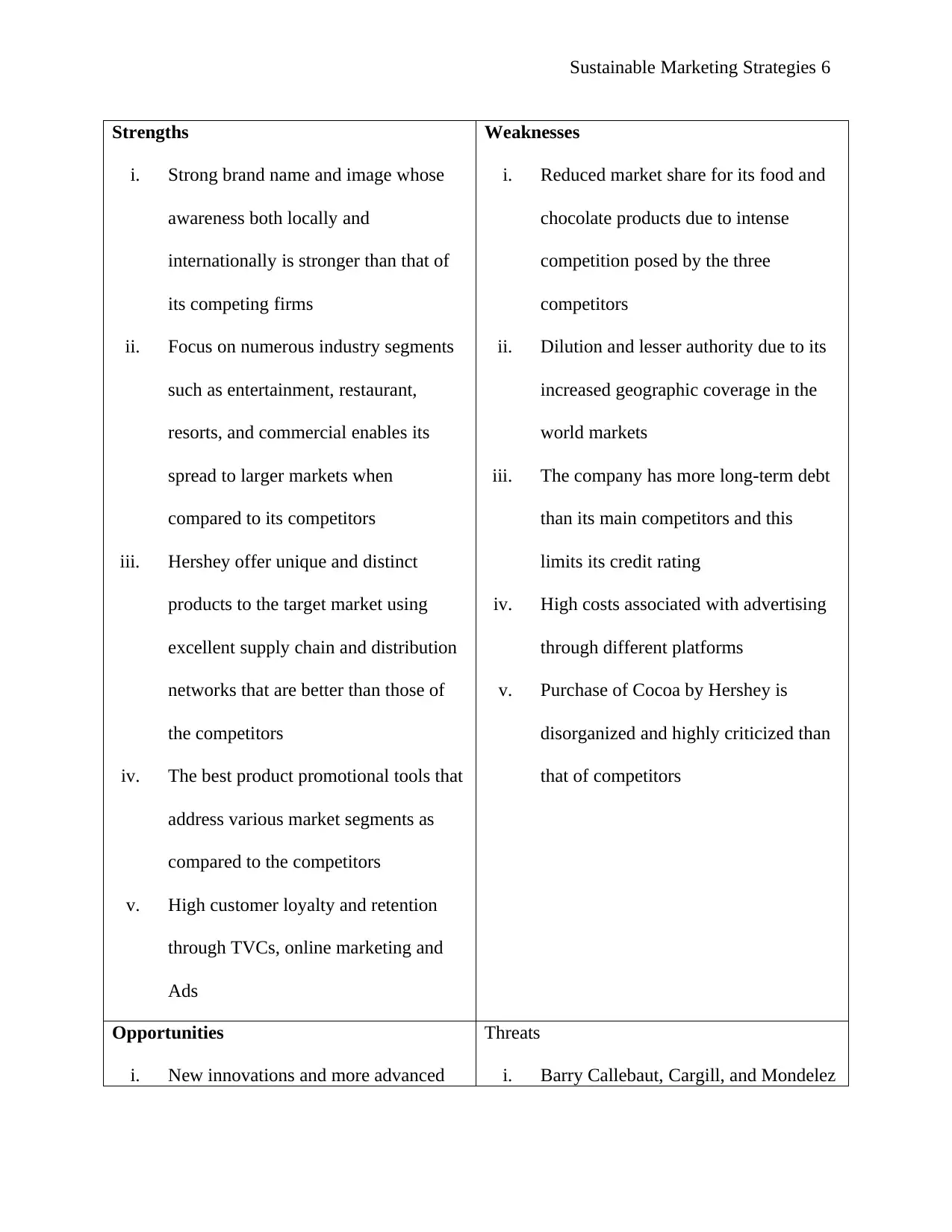
Sustainable Marketing Strategies 6
Strengths
i. Strong brand name and image whose
awareness both locally and
internationally is stronger than that of
its competing firms
ii. Focus on numerous industry segments
such as entertainment, restaurant,
resorts, and commercial enables its
spread to larger markets when
compared to its competitors
iii. Hershey offer unique and distinct
products to the target market using
excellent supply chain and distribution
networks that are better than those of
the competitors
iv. The best product promotional tools that
address various market segments as
compared to the competitors
v. High customer loyalty and retention
through TVCs, online marketing and
Ads
Weaknesses
i. Reduced market share for its food and
chocolate products due to intense
competition posed by the three
competitors
ii. Dilution and lesser authority due to its
increased geographic coverage in the
world markets
iii. The company has more long-term debt
than its main competitors and this
limits its credit rating
iv. High costs associated with advertising
through different platforms
v. Purchase of Cocoa by Hershey is
disorganized and highly criticized than
that of competitors
Opportunities
i. New innovations and more advanced
Threats
i. Barry Callebaut, Cargill, and Mondelez
Strengths
i. Strong brand name and image whose
awareness both locally and
internationally is stronger than that of
its competing firms
ii. Focus on numerous industry segments
such as entertainment, restaurant,
resorts, and commercial enables its
spread to larger markets when
compared to its competitors
iii. Hershey offer unique and distinct
products to the target market using
excellent supply chain and distribution
networks that are better than those of
the competitors
iv. The best product promotional tools that
address various market segments as
compared to the competitors
v. High customer loyalty and retention
through TVCs, online marketing and
Ads
Weaknesses
i. Reduced market share for its food and
chocolate products due to intense
competition posed by the three
competitors
ii. Dilution and lesser authority due to its
increased geographic coverage in the
world markets
iii. The company has more long-term debt
than its main competitors and this
limits its credit rating
iv. High costs associated with advertising
through different platforms
v. Purchase of Cocoa by Hershey is
disorganized and highly criticized than
that of competitors
Opportunities
i. New innovations and more advanced
Threats
i. Barry Callebaut, Cargill, and Mondelez
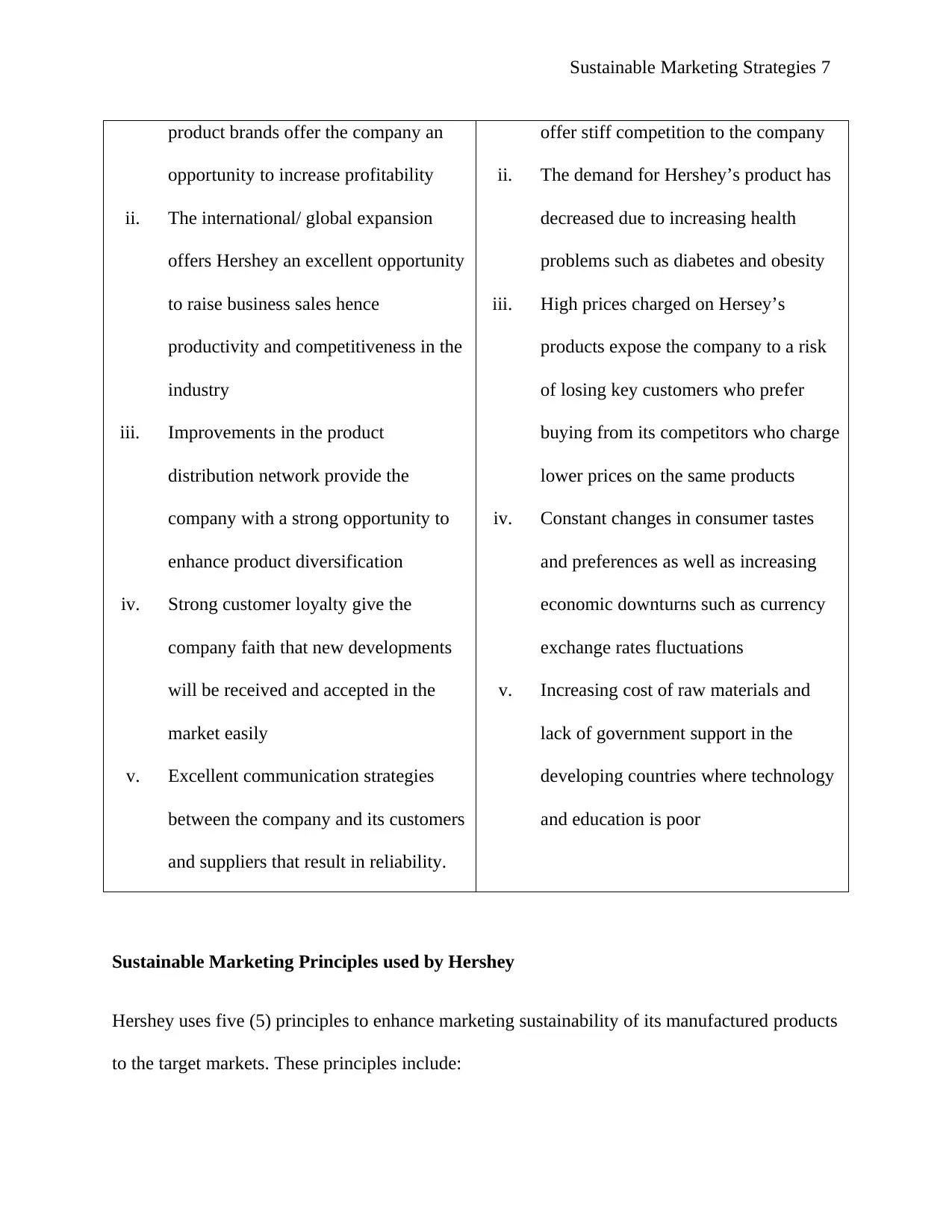
Sustainable Marketing Strategies 7
product brands offer the company an
opportunity to increase profitability
ii. The international/ global expansion
offers Hershey an excellent opportunity
to raise business sales hence
productivity and competitiveness in the
industry
iii. Improvements in the product
distribution network provide the
company with a strong opportunity to
enhance product diversification
iv. Strong customer loyalty give the
company faith that new developments
will be received and accepted in the
market easily
v. Excellent communication strategies
between the company and its customers
and suppliers that result in reliability.
offer stiff competition to the company
ii. The demand for Hershey’s product has
decreased due to increasing health
problems such as diabetes and obesity
iii. High prices charged on Hersey’s
products expose the company to a risk
of losing key customers who prefer
buying from its competitors who charge
lower prices on the same products
iv. Constant changes in consumer tastes
and preferences as well as increasing
economic downturns such as currency
exchange rates fluctuations
v. Increasing cost of raw materials and
lack of government support in the
developing countries where technology
and education is poor
Sustainable Marketing Principles used by Hershey
Hershey uses five (5) principles to enhance marketing sustainability of its manufactured products
to the target markets. These principles include:
product brands offer the company an
opportunity to increase profitability
ii. The international/ global expansion
offers Hershey an excellent opportunity
to raise business sales hence
productivity and competitiveness in the
industry
iii. Improvements in the product
distribution network provide the
company with a strong opportunity to
enhance product diversification
iv. Strong customer loyalty give the
company faith that new developments
will be received and accepted in the
market easily
v. Excellent communication strategies
between the company and its customers
and suppliers that result in reliability.
offer stiff competition to the company
ii. The demand for Hershey’s product has
decreased due to increasing health
problems such as diabetes and obesity
iii. High prices charged on Hersey’s
products expose the company to a risk
of losing key customers who prefer
buying from its competitors who charge
lower prices on the same products
iv. Constant changes in consumer tastes
and preferences as well as increasing
economic downturns such as currency
exchange rates fluctuations
v. Increasing cost of raw materials and
lack of government support in the
developing countries where technology
and education is poor
Sustainable Marketing Principles used by Hershey
Hershey uses five (5) principles to enhance marketing sustainability of its manufactured products
to the target markets. These principles include:
Paraphrase This Document
Need a fresh take? Get an instant paraphrase of this document with our AI Paraphraser
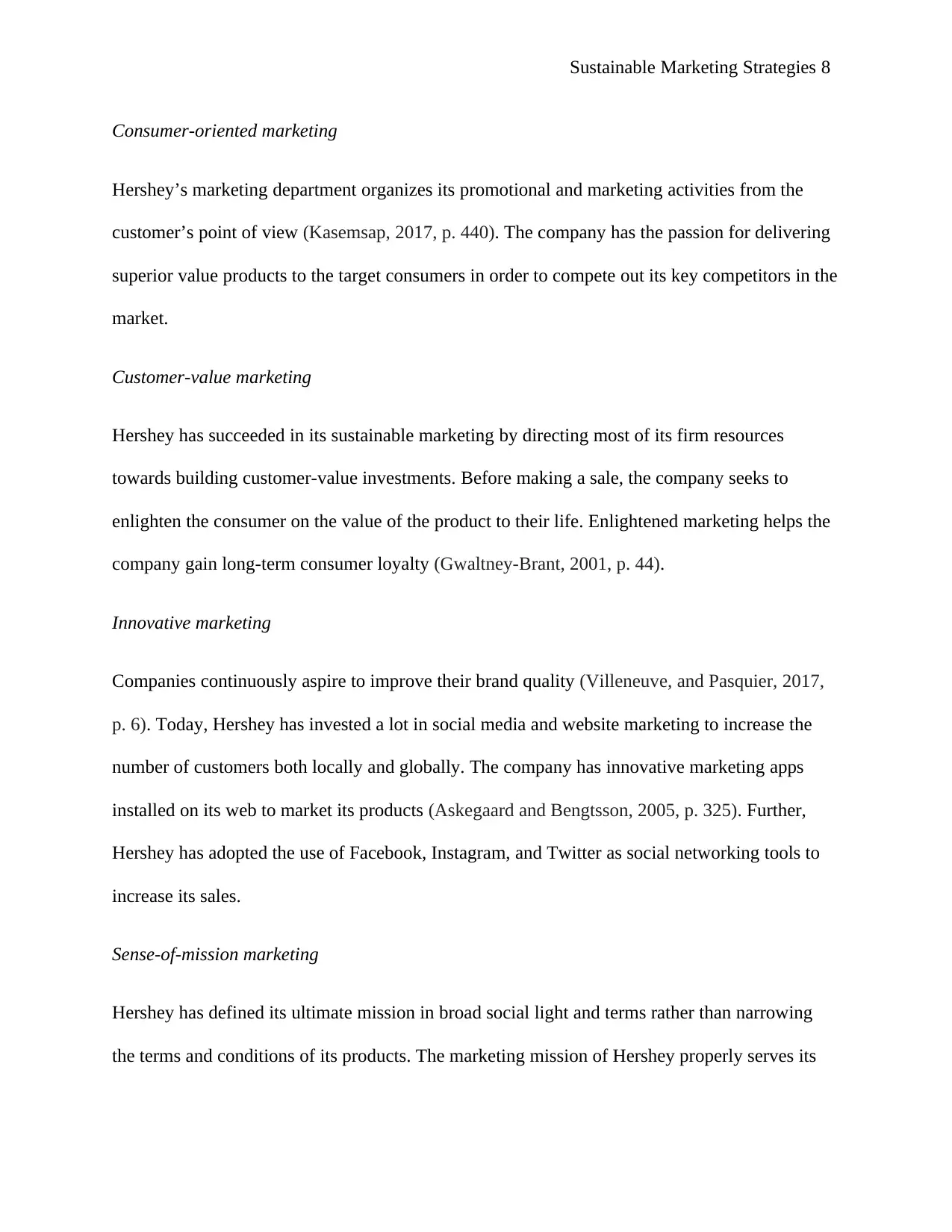
Sustainable Marketing Strategies 8
Consumer-oriented marketing
Hershey’s marketing department organizes its promotional and marketing activities from the
customer’s point of view (Kasemsap, 2017, p. 440). The company has the passion for delivering
superior value products to the target consumers in order to compete out its key competitors in the
market.
Customer-value marketing
Hershey has succeeded in its sustainable marketing by directing most of its firm resources
towards building customer-value investments. Before making a sale, the company seeks to
enlighten the consumer on the value of the product to their life. Enlightened marketing helps the
company gain long-term consumer loyalty (Gwaltney-Brant, 2001, p. 44).
Innovative marketing
Companies continuously aspire to improve their brand quality (Villeneuve, and Pasquier, 2017,
p. 6). Today, Hershey has invested a lot in social media and website marketing to increase the
number of customers both locally and globally. The company has innovative marketing apps
installed on its web to market its products (Askegaard and Bengtsson, 2005, p. 325). Further,
Hershey has adopted the use of Facebook, Instagram, and Twitter as social networking tools to
increase its sales.
Sense-of-mission marketing
Hershey has defined its ultimate mission in broad social light and terms rather than narrowing
the terms and conditions of its products. The marketing mission of Hershey properly serves its
Consumer-oriented marketing
Hershey’s marketing department organizes its promotional and marketing activities from the
customer’s point of view (Kasemsap, 2017, p. 440). The company has the passion for delivering
superior value products to the target consumers in order to compete out its key competitors in the
market.
Customer-value marketing
Hershey has succeeded in its sustainable marketing by directing most of its firm resources
towards building customer-value investments. Before making a sale, the company seeks to
enlighten the consumer on the value of the product to their life. Enlightened marketing helps the
company gain long-term consumer loyalty (Gwaltney-Brant, 2001, p. 44).
Innovative marketing
Companies continuously aspire to improve their brand quality (Villeneuve, and Pasquier, 2017,
p. 6). Today, Hershey has invested a lot in social media and website marketing to increase the
number of customers both locally and globally. The company has innovative marketing apps
installed on its web to market its products (Askegaard and Bengtsson, 2005, p. 325). Further,
Hershey has adopted the use of Facebook, Instagram, and Twitter as social networking tools to
increase its sales.
Sense-of-mission marketing
Hershey has defined its ultimate mission in broad social light and terms rather than narrowing
the terms and conditions of its products. The marketing mission of Hershey properly serves its
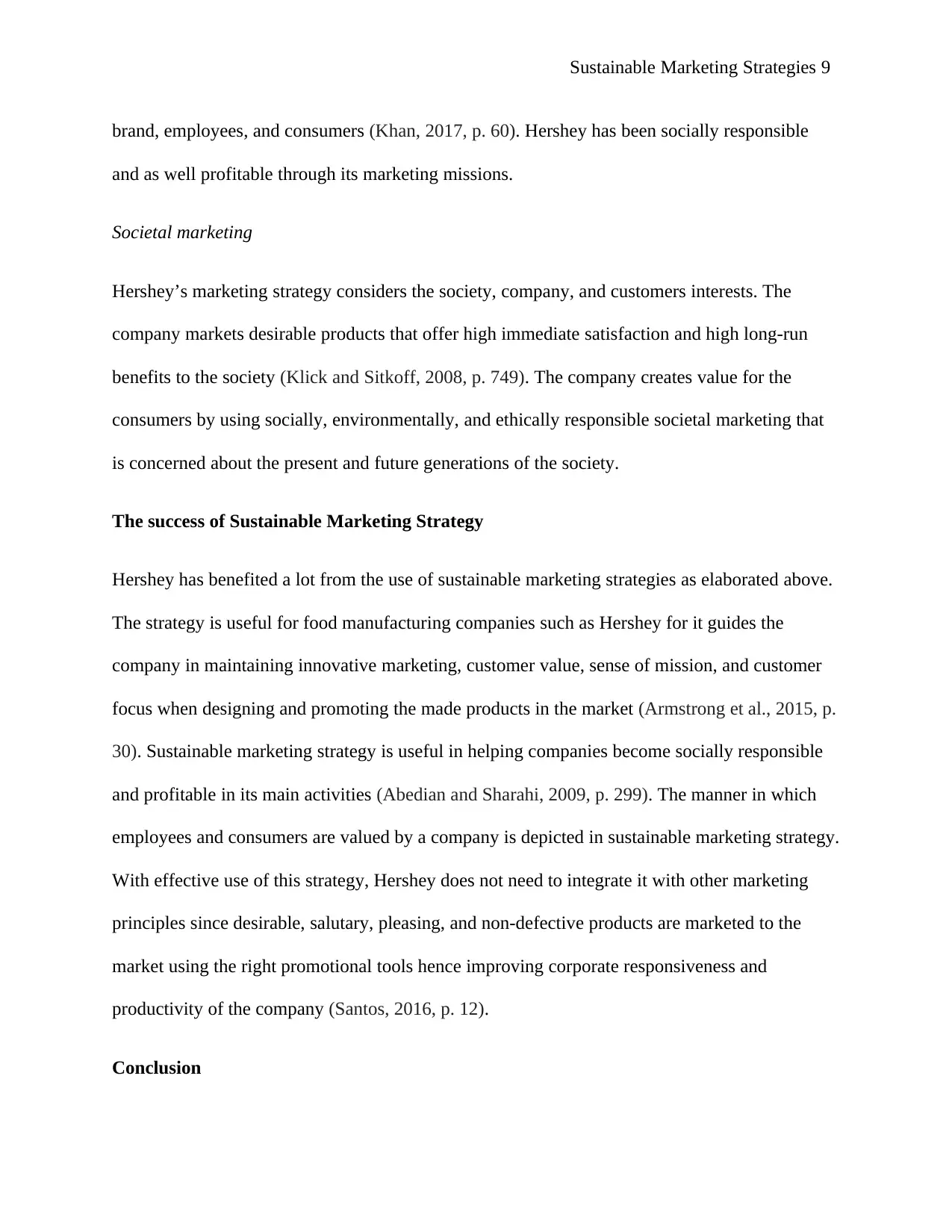
Sustainable Marketing Strategies 9
brand, employees, and consumers (Khan, 2017, p. 60). Hershey has been socially responsible
and as well profitable through its marketing missions.
Societal marketing
Hershey’s marketing strategy considers the society, company, and customers interests. The
company markets desirable products that offer high immediate satisfaction and high long-run
benefits to the society (Klick and Sitkoff, 2008, p. 749). The company creates value for the
consumers by using socially, environmentally, and ethically responsible societal marketing that
is concerned about the present and future generations of the society.
The success of Sustainable Marketing Strategy
Hershey has benefited a lot from the use of sustainable marketing strategies as elaborated above.
The strategy is useful for food manufacturing companies such as Hershey for it guides the
company in maintaining innovative marketing, customer value, sense of mission, and customer
focus when designing and promoting the made products in the market (Armstrong et al., 2015, p.
30). Sustainable marketing strategy is useful in helping companies become socially responsible
and profitable in its main activities (Abedian and Sharahi, 2009, p. 299). The manner in which
employees and consumers are valued by a company is depicted in sustainable marketing strategy.
With effective use of this strategy, Hershey does not need to integrate it with other marketing
principles since desirable, salutary, pleasing, and non-defective products are marketed to the
market using the right promotional tools hence improving corporate responsiveness and
productivity of the company (Santos, 2016, p. 12).
Conclusion
brand, employees, and consumers (Khan, 2017, p. 60). Hershey has been socially responsible
and as well profitable through its marketing missions.
Societal marketing
Hershey’s marketing strategy considers the society, company, and customers interests. The
company markets desirable products that offer high immediate satisfaction and high long-run
benefits to the society (Klick and Sitkoff, 2008, p. 749). The company creates value for the
consumers by using socially, environmentally, and ethically responsible societal marketing that
is concerned about the present and future generations of the society.
The success of Sustainable Marketing Strategy
Hershey has benefited a lot from the use of sustainable marketing strategies as elaborated above.
The strategy is useful for food manufacturing companies such as Hershey for it guides the
company in maintaining innovative marketing, customer value, sense of mission, and customer
focus when designing and promoting the made products in the market (Armstrong et al., 2015, p.
30). Sustainable marketing strategy is useful in helping companies become socially responsible
and profitable in its main activities (Abedian and Sharahi, 2009, p. 299). The manner in which
employees and consumers are valued by a company is depicted in sustainable marketing strategy.
With effective use of this strategy, Hershey does not need to integrate it with other marketing
principles since desirable, salutary, pleasing, and non-defective products are marketed to the
market using the right promotional tools hence improving corporate responsiveness and
productivity of the company (Santos, 2016, p. 12).
Conclusion
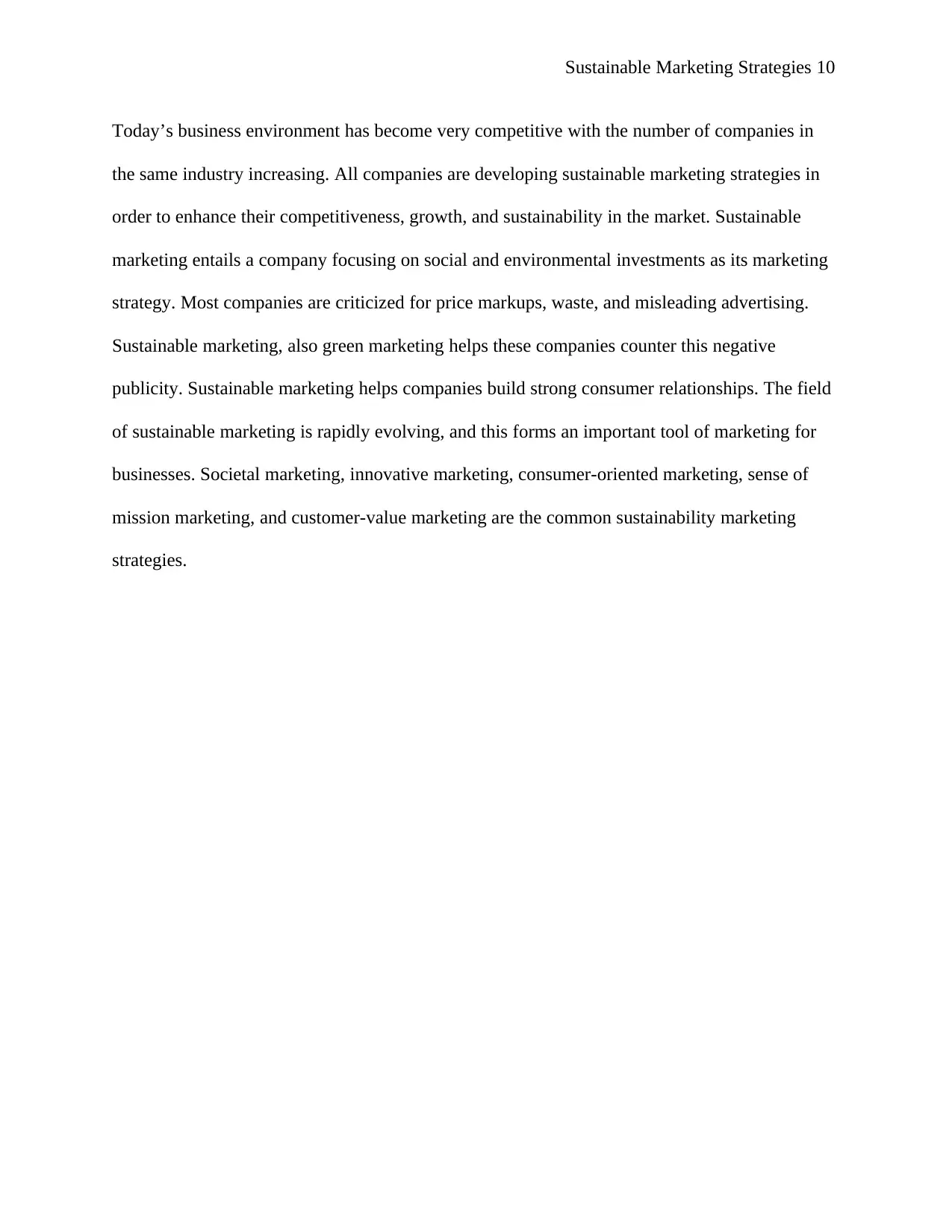
Sustainable Marketing Strategies 10
Today’s business environment has become very competitive with the number of companies in
the same industry increasing. All companies are developing sustainable marketing strategies in
order to enhance their competitiveness, growth, and sustainability in the market. Sustainable
marketing entails a company focusing on social and environmental investments as its marketing
strategy. Most companies are criticized for price markups, waste, and misleading advertising.
Sustainable marketing, also green marketing helps these companies counter this negative
publicity. Sustainable marketing helps companies build strong consumer relationships. The field
of sustainable marketing is rapidly evolving, and this forms an important tool of marketing for
businesses. Societal marketing, innovative marketing, consumer-oriented marketing, sense of
mission marketing, and customer-value marketing are the common sustainability marketing
strategies.
Today’s business environment has become very competitive with the number of companies in
the same industry increasing. All companies are developing sustainable marketing strategies in
order to enhance their competitiveness, growth, and sustainability in the market. Sustainable
marketing entails a company focusing on social and environmental investments as its marketing
strategy. Most companies are criticized for price markups, waste, and misleading advertising.
Sustainable marketing, also green marketing helps these companies counter this negative
publicity. Sustainable marketing helps companies build strong consumer relationships. The field
of sustainable marketing is rapidly evolving, and this forms an important tool of marketing for
businesses. Societal marketing, innovative marketing, consumer-oriented marketing, sense of
mission marketing, and customer-value marketing are the common sustainability marketing
strategies.
Secure Best Marks with AI Grader
Need help grading? Try our AI Grader for instant feedback on your assignments.
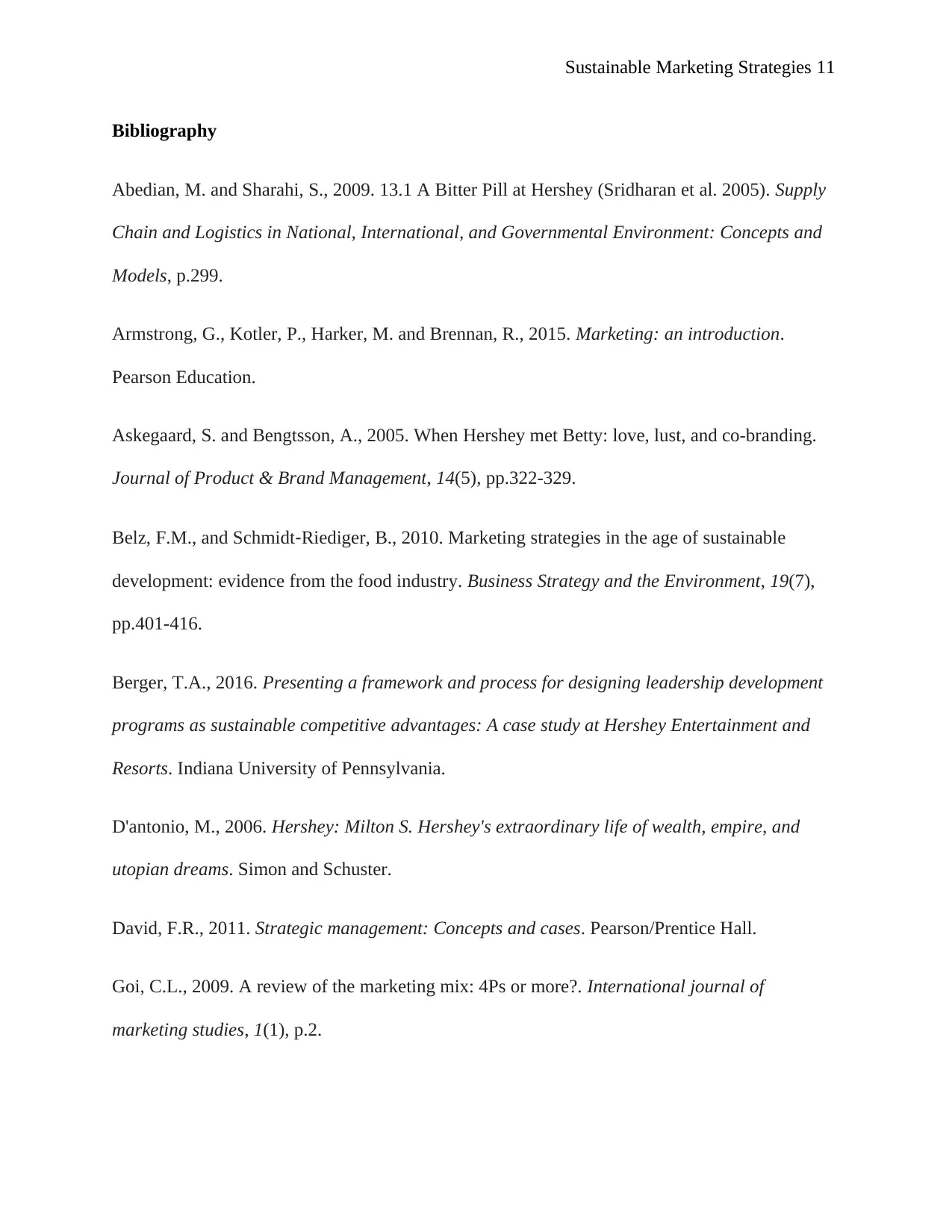
Sustainable Marketing Strategies 11
Bibliography
Abedian, M. and Sharahi, S., 2009. 13.1 A Bitter Pill at Hershey (Sridharan et al. 2005). Supply
Chain and Logistics in National, International, and Governmental Environment: Concepts and
Models, p.299.
Armstrong, G., Kotler, P., Harker, M. and Brennan, R., 2015. Marketing: an introduction.
Pearson Education.
Askegaard, S. and Bengtsson, A., 2005. When Hershey met Betty: love, lust, and co-branding.
Journal of Product & Brand Management, 14(5), pp.322-329.
Belz, F.M., and Schmidt‐Riediger, B., 2010. Marketing strategies in the age of sustainable
development: evidence from the food industry. Business Strategy and the Environment, 19(7),
pp.401-416.
Berger, T.A., 2016. Presenting a framework and process for designing leadership development
programs as sustainable competitive advantages: A case study at Hershey Entertainment and
Resorts. Indiana University of Pennsylvania.
D'antonio, M., 2006. Hershey: Milton S. Hershey's extraordinary life of wealth, empire, and
utopian dreams. Simon and Schuster.
David, F.R., 2011. Strategic management: Concepts and cases. Pearson/Prentice Hall.
Goi, C.L., 2009. A review of the marketing mix: 4Ps or more?. International journal of
marketing studies, 1(1), p.2.
Bibliography
Abedian, M. and Sharahi, S., 2009. 13.1 A Bitter Pill at Hershey (Sridharan et al. 2005). Supply
Chain and Logistics in National, International, and Governmental Environment: Concepts and
Models, p.299.
Armstrong, G., Kotler, P., Harker, M. and Brennan, R., 2015. Marketing: an introduction.
Pearson Education.
Askegaard, S. and Bengtsson, A., 2005. When Hershey met Betty: love, lust, and co-branding.
Journal of Product & Brand Management, 14(5), pp.322-329.
Belz, F.M., and Schmidt‐Riediger, B., 2010. Marketing strategies in the age of sustainable
development: evidence from the food industry. Business Strategy and the Environment, 19(7),
pp.401-416.
Berger, T.A., 2016. Presenting a framework and process for designing leadership development
programs as sustainable competitive advantages: A case study at Hershey Entertainment and
Resorts. Indiana University of Pennsylvania.
D'antonio, M., 2006. Hershey: Milton S. Hershey's extraordinary life of wealth, empire, and
utopian dreams. Simon and Schuster.
David, F.R., 2011. Strategic management: Concepts and cases. Pearson/Prentice Hall.
Goi, C.L., 2009. A review of the marketing mix: 4Ps or more?. International journal of
marketing studies, 1(1), p.2.
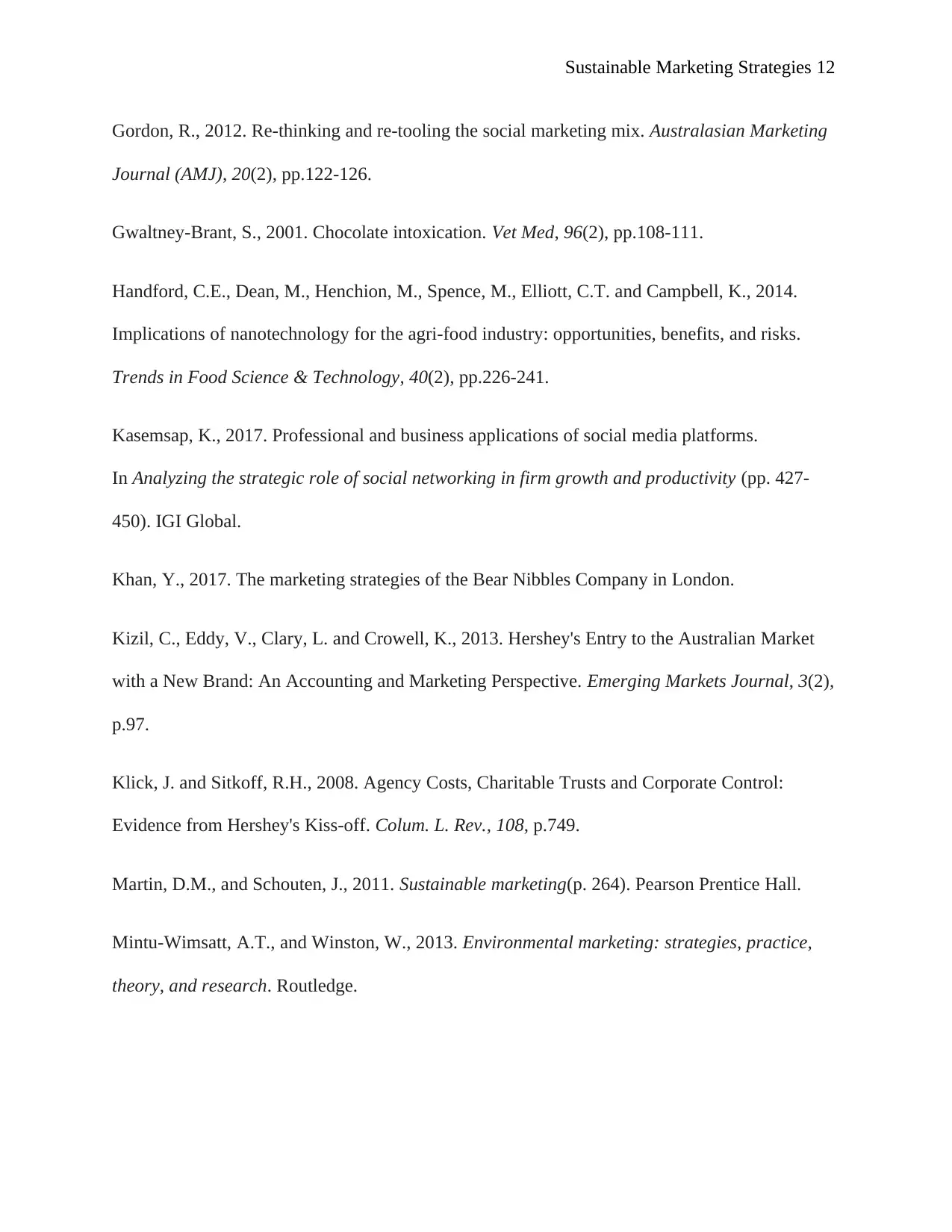
Sustainable Marketing Strategies 12
Gordon, R., 2012. Re-thinking and re-tooling the social marketing mix. Australasian Marketing
Journal (AMJ), 20(2), pp.122-126.
Gwaltney-Brant, S., 2001. Chocolate intoxication. Vet Med, 96(2), pp.108-111.
Handford, C.E., Dean, M., Henchion, M., Spence, M., Elliott, C.T. and Campbell, K., 2014.
Implications of nanotechnology for the agri-food industry: opportunities, benefits, and risks.
Trends in Food Science & Technology, 40(2), pp.226-241.
Kasemsap, K., 2017. Professional and business applications of social media platforms.
In Analyzing the strategic role of social networking in firm growth and productivity (pp. 427-
450). IGI Global.
Khan, Y., 2017. The marketing strategies of the Bear Nibbles Company in London.
Kizil, C., Eddy, V., Clary, L. and Crowell, K., 2013. Hershey's Entry to the Australian Market
with a New Brand: An Accounting and Marketing Perspective. Emerging Markets Journal, 3(2),
p.97.
Klick, J. and Sitkoff, R.H., 2008. Agency Costs, Charitable Trusts and Corporate Control:
Evidence from Hershey's Kiss-off. Colum. L. Rev., 108, p.749.
Martin, D.M., and Schouten, J., 2011. Sustainable marketing(p. 264). Pearson Prentice Hall.
Mintu-Wimsatt, A.T., and Winston, W., 2013. Environmental marketing: strategies, practice,
theory, and research. Routledge.
Gordon, R., 2012. Re-thinking and re-tooling the social marketing mix. Australasian Marketing
Journal (AMJ), 20(2), pp.122-126.
Gwaltney-Brant, S., 2001. Chocolate intoxication. Vet Med, 96(2), pp.108-111.
Handford, C.E., Dean, M., Henchion, M., Spence, M., Elliott, C.T. and Campbell, K., 2014.
Implications of nanotechnology for the agri-food industry: opportunities, benefits, and risks.
Trends in Food Science & Technology, 40(2), pp.226-241.
Kasemsap, K., 2017. Professional and business applications of social media platforms.
In Analyzing the strategic role of social networking in firm growth and productivity (pp. 427-
450). IGI Global.
Khan, Y., 2017. The marketing strategies of the Bear Nibbles Company in London.
Kizil, C., Eddy, V., Clary, L. and Crowell, K., 2013. Hershey's Entry to the Australian Market
with a New Brand: An Accounting and Marketing Perspective. Emerging Markets Journal, 3(2),
p.97.
Klick, J. and Sitkoff, R.H., 2008. Agency Costs, Charitable Trusts and Corporate Control:
Evidence from Hershey's Kiss-off. Colum. L. Rev., 108, p.749.
Martin, D.M., and Schouten, J., 2011. Sustainable marketing(p. 264). Pearson Prentice Hall.
Mintu-Wimsatt, A.T., and Winston, W., 2013. Environmental marketing: strategies, practice,
theory, and research. Routledge.
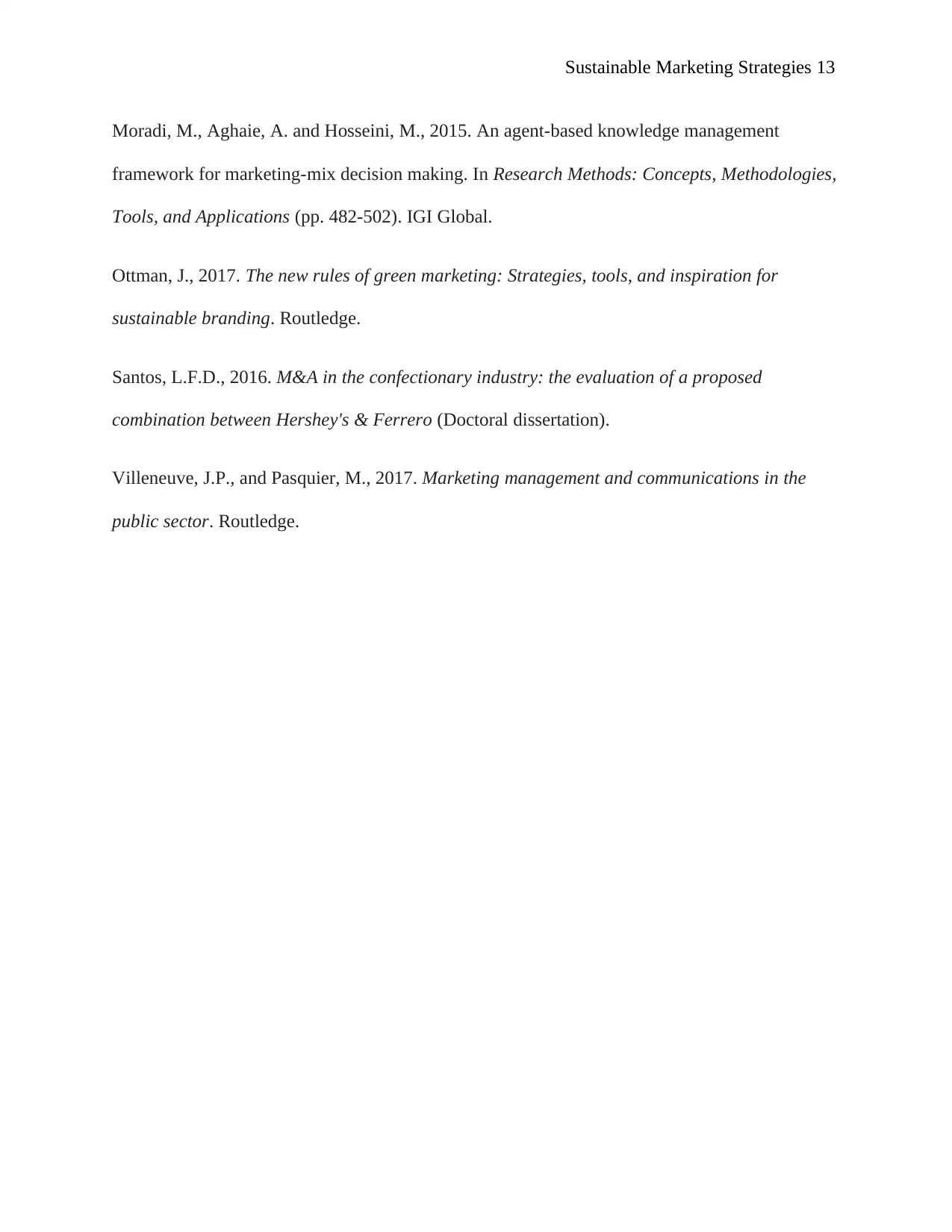
Sustainable Marketing Strategies 13
Moradi, M., Aghaie, A. and Hosseini, M., 2015. An agent-based knowledge management
framework for marketing-mix decision making. In Research Methods: Concepts, Methodologies,
Tools, and Applications (pp. 482-502). IGI Global.
Ottman, J., 2017. The new rules of green marketing: Strategies, tools, and inspiration for
sustainable branding. Routledge.
Santos, L.F.D., 2016. M&A in the confectionary industry: the evaluation of a proposed
combination between Hershey's & Ferrero (Doctoral dissertation).
Villeneuve, J.P., and Pasquier, M., 2017. Marketing management and communications in the
public sector. Routledge.
Moradi, M., Aghaie, A. and Hosseini, M., 2015. An agent-based knowledge management
framework for marketing-mix decision making. In Research Methods: Concepts, Methodologies,
Tools, and Applications (pp. 482-502). IGI Global.
Ottman, J., 2017. The new rules of green marketing: Strategies, tools, and inspiration for
sustainable branding. Routledge.
Santos, L.F.D., 2016. M&A in the confectionary industry: the evaluation of a proposed
combination between Hershey's & Ferrero (Doctoral dissertation).
Villeneuve, J.P., and Pasquier, M., 2017. Marketing management and communications in the
public sector. Routledge.
1 out of 13
Related Documents
Your All-in-One AI-Powered Toolkit for Academic Success.
+13062052269
info@desklib.com
Available 24*7 on WhatsApp / Email
![[object Object]](/_next/static/media/star-bottom.7253800d.svg)
Unlock your academic potential
© 2024 | Zucol Services PVT LTD | All rights reserved.




